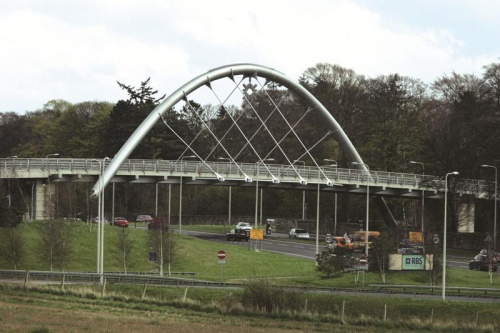A8 Gogarburn Bridge
This spectacular two-lane highway bridge provides the main access from the A8 into the site of the world headquarters of the Royal Bank of Scotland. The 400t steel superstructure comprises a tubular parabolic arch, which spans diagonally across the carriageway and supports the suspended deck via an asymmetrical arrangement of tie rods.
The main steel grades used are listed below. There was also a requirement for some of the S355J2 material to have guaranteed through thickness ductility, i.e. Z25 to EN 10164[1].
- S355J2 to EN 10025-2[2] for plates up to 50mm thick.
- S355NL to EN 10025-3[3] for plates 85mm thick and over.
Interestingly, the radar signature, as seen from Edinburgh Airport, influenced the positioning of the bridge, as did the location of existing mature trees.
The arch is a 1300mm diameter tube made from 40mm thick plate, which was rolled into a circular section then curved along its length prior to fabrication. The site joints were formed by insitu welding to maintain the smooth appearance of the arch. The hangers are 100mm diameter solid bars connected via fork ends at the top and bottom with adjustable turnbuckles.
The bridge was erected in a series of overnight closures to minimize disruption to the busy A8, and was opened in 2005.
| Architect | Michael Laird and RHWL |
| Structural Engineer | Anthony Hunt Associates |
| Steelwork Contractor | Watson Steel Structures Ltd. (now Severfield (UK) Ltd) |
| Main Contractor | Sir Robert McAlpine |
| Client | Royal Bank of Scotland |
References
- ↑ BS EN 10164: 2004, Steel products with improved deformation properties perpendicular to the surface of the product - technical delivery conditions. BSI
- ↑ BS EN 10025-2: 2004, Hot rolled products of structural steels, Part 2: Technical delivery conditions for non-alloy structural steels, BSI
- ↑ BS EN 10025-3: 2004, Hot rolled products of structural steels, Part 3: Technical delivery conditions for normalized / normalized rolled weldable fine grain structural steels, BSI




